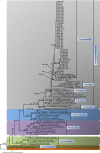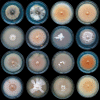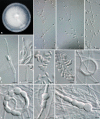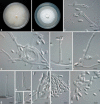Plectosphaerella species associated with root and collar rots of horticultural crops in southern Italy
- PMID: 23105152
- PMCID: PMC3409414
- DOI: 10.3767/003158512X638251
Plectosphaerella species associated with root and collar rots of horticultural crops in southern Italy
Abstract
Plectosphaerella cucumerina, most frequently encountered in its Plectosporium state, is well known as a pathogen of several plant species causing fruit, root and collar rot, and collapse. It is considered to pose a serious threat to melon (Cucumis melo) production in Italy. In the present study, an intensive sampling of diseased cucurbits as well as tomato and bell pepper was done and the fungal pathogens present on them were isolated. Phylogenetic relationships of the isolates were determined through a study of ribosomal RNA gene sequences (ITS cluster and D1/D2 domain of the 28S rRNA gene). Combining morphological, culture and molecular data, six species were distinguished. One of these (Pa. cucumerina) is already known. Four new species are described as Plectosphaerella citrullae, Pa. pauciseptata, Pa. plurivora and Pa. ramiseptata. Acremonium cucurbitacearum is shown to be a synonym of Nodulisporium melonis and is transferred to Plectosphaerella as Plectosphaerella melonis comb. nov. A further three known species of Plectosporium are recombined in Plectosphaerella.
Keywords: D1/D2; ITS; LSU; Plectosporium; phylogeny; rDNA; systematics; taxonomy.
Figures









References
-
- Alfaro-Garcìa A, Armengol J, Bruton BD, Gams W, Garcìa-Jimenez J, Martinez-Ferrer G. 1996. The taxonomic position of the causal agent of Acremonium collapse of muskmelon. Mycologia 88: 804–808
-
- Alves A, Correia A, Luque J, Phillips AJL. 2004. Botryosphaeria corticola sp. nov. on Quercus species, with notes and description of Botryosphaeria stevensii and its anamorph Diplodia mutila. Mycologia 96: 598–613 - PubMed
-
- Anonymous. 2010. http://agri.istat.it/sag_is_pdwout/index.jsp
-
- Antignani V, Gams W, Marziano F. 2008. Plectosporium delsorboi nov. sp., a pathogen of Curcuma, Zingiberaceae. Nova Hedwigia 86: 209–214
-
- Armengol J, Sanz E, Martínez-Ferrer G, Sales R, Bruton BD, García-Jiménez J. 1998. Host range of Acremonium cucurbitacearum, cause of Acremonium collapse of muskmelon. Plant Pathology 47: 29–35
LinkOut - more resources
Full Text Sources
Molecular Biology Databases
